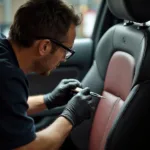Owning an older car doesn’t mean you have to sacrifice comfort. One of the telltale signs of a car’s age is often the condition of its seats. Worn out old car seats can be an eyesore and uncomfortable, but thankfully, repairing them is often more affordable than a full replacement. In this guide, we’ll explore various methods for how to repair a worn out old car seat and bring back that new-car feeling.
Assessing the Damage: What Needs Fixing?
Before diving into repairs, it’s essential to identify the specific issues plaguing your car seats.
- Cracks and Tears: Common on leather and vinyl seats, these can result from age, sun exposure, and wear.
- Fading and Discoloration: Years of sun exposure can leave your seats looking dull and faded.
- Stains and Spills: Accidents happen, and over time, spills can leave lasting marks on your seats.
- Sagging and Loss of Support: Worn-out foam padding can lead to a noticeable (and uncomfortable) sinking feeling.
DIY Repair Options for Worn Out Old Car Seats
For those who enjoy a good hands-on project, there are several DIY repair options depending on the damage:
1. Repairing Cracks and Tears
-
Leather and Vinyl Repair Kits: These kits typically include a color-matched compound, adhesive, and tools to patch up cracks and tears. Follow the kit’s instructions carefully, and be sure to clean the area thoroughly before application.
-
Liquid Leather or Vinyl Repair: This option works well for smaller cracks and scratches. Choose a color that closely matches your seat and apply thin, even coats, allowing each coat to dry completely before applying the next.
2. Addressing Fading and Discoloration
-
Leather and Vinyl Dyes: These dyes penetrate the material’s surface, restoring its original color. Choose a high-quality dye specifically designed for car interiors and follow the manufacturer’s instructions diligently.
-
Leather and Vinyl Conditioning Treatments: Regular conditioning helps to keep the material supple and can minimize the appearance of fading over time.
3. Tackling Stains and Spills
-
Upholstery Cleaner: Opt for a cleaner designed for your specific seat material (leather, vinyl, cloth). Test the cleaner on a hidden area first to ensure colorfastness.
-
DIY Cleaning Solutions: For fabric seats, a mixture of mild detergent and warm water can often remove mild stains. Avoid harsh chemicals or abrasive cleaners.
4. Restoring Comfort with New Padding
-
Replacement Seat Cushions: If the existing foam padding is beyond repair, consider replacing it altogether. You can find pre-made seat cushions or have them custom-made for a perfect fit.
-
Adding Extra Padding: For a less intensive approach, you can add extra layers of foam padding beneath the existing cover. This can help improve comfort and support.
When to Call in the Professionals
While DIY repairs can be cost-effective, some situations warrant professional help. Consider consulting with a car upholstery specialist if:
- The damage is extensive or involves complex repairs.
- You’re uncomfortable working with specialized materials or tools.
- You want a flawless finish that only a professional can deliver.
Tips for Maintaining Your Repaired Car Seats
Once you’ve put in the effort to repair your worn out old car seats, it’s worth taking steps to keep them looking their best:
- Regular Cleaning: Wipe down your seats weekly using a soft cloth and appropriate cleaner.
- UV Protection: Park your car in the shade or use a windshield sunshade to minimize UV damage.
- Seat Covers: Consider using seat covers, especially if your car sees a lot of use or you frequently transport pets or children.
Conclusion
Repairing worn out old car seats is an achievable way to revitalize your car’s interior and enhance your driving experience. Whether you opt for DIY solutions or seek professional assistance, you can enjoy the comfort and aesthetics of refreshed car seats without breaking the bank. Remember, regular maintenance goes a long way in extending the lifespan of your car seats and keeping them looking their best for years to come.
FAQs About Car Seat Repair
Can I dye my cloth car seats?
While you can dye cloth car seats, it can be challenging to achieve even coverage and prevent the dye from bleeding. It’s often recommended to consult with a professional for best results.
How do you repair leather seats in a car?
Leather car seat repair often involves using specialized repair kits, dyes, and conditioners. For a comprehensive guide, check out our article on how do you repair leather seats in a car.
What is the best leather repair for car seats?
Choosing the best leather repair for your car seats depends on the type and extent of the damage. We’ve compiled a list of the best leather repair for car seats to help you find the right product.
Can I repair a cigarette burn hole in my car seat?
Yes, small cigarette burns can often be repaired using a leather or vinyl repair kit.
How much does it cost to reupholster car seats?
The cost of reupholstering car seats varies depending on factors such as the material, the complexity of the job, and your location. You can expect to pay anywhere from a few hundred dollars to over a thousand for a complete reupholstery job.
Need help with those worn-out car seats? Contact us!
Our team of experts is just a message away. Reach out to us on WhatsApp at +1(641)206-8880 or email us at [email protected]. We’re here for you 24/7.



